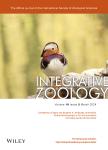Latitudinal and seasonal variation in reproductive effort of the eastern fence lizard (Sceloporus undulatus)
在东方篱笆蜥蜴(Sceloporus undulatus ) 的繁殖努力的纬度、季节的变化作者机构:Key Lab of Animal Ecology and Conservation BiologyInstitute of ZoologyChinese Academy of SciencesBeijingChina Department of BiologyPennsylvania State UniversityUniversity ParkPennsylvaniaUSA Department of EcologyEvolution and Organismal BiologyIowa State UniversityAmesIowaUSA School of Biological SciencesUniversity of SydneyNew South WalesAustralia
出 版 物:《Integrative Zoology》 (整合动物学(英文版))
年 卷 期:2014年第9卷第3期
页 面:360-371页
核心收录:
学科分类:08[工学] 080502[工学-材料学] 0805[工学-材料科学与工程(可授工学、理学学位)]
基 金:This work was supported by grants from the Natural Science Foundation of China,‘One Hundred Talents Program’of the Chinese Academy of Sciences and the University of Sydney(to W.Du) the Australian Research Council(to R.Shine) the US National Science Foundation(DEB0949483 to T.Langkilde) D.Warner was supported by a grant from the US National Science Foundation(DEB0640932 to F.Janzen)during this research and T.R.Robbins by Sigma Xi Grants-in-Aid of Research
主 题:clutch size geographic variation local adaptation offspring size reproductive investment
摘 要:Geographic variation in life-history traits among populations of wide-ranging species is influenced by both spatial and temporal aspects of the environment. Rarely, however, are the effects of both aspects examined concurrently. We collected gravid female lizards (Sceloporus undulatus) from northern (Indiana), central (Mississippi) and southern (Florida) populations, spanning nearly the full latitudinal range of the species, to examine among-population differences in strategies of reproductive energy allocation. Adult females from the southern population were smaller, and produced fewer and smaller eggs in their first clutches than did females from the more northern populations. Southern females were more likely to produce a second clutch, and second clutches were smaller than first clutches for females from the 2 northern populations. Together these trends eliminated population differences in overall reproductive output after accounting for body size. The trend for greater reproductive energy to be allocated to first clutches at higher latitudes, and to later clutches at lower latitudes is corroborated by published data from field studies on multiple populations. Distributing reproductive effort by producing more clutches of smaller eggs may be an adaptive response to the long season available for egg incubation and lizard activity in sub-tropical southern environments. In contrast, allocating greater resources to early reproduction may enhance maternal fitness in the relatively short activity seasons that characterize more northern sites.



